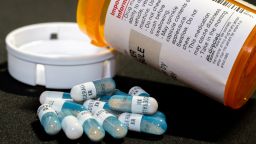When a pharmaceutical plant in Shanghai that made contrast material for radiological scans shut down last year, half the United States’ supply of the radioactive substance immediately became unavailable. Health care providers had to make difficult choices about who got potentially lifesaving tests.
“I work in the VA system. This impacted veterans literally overnight, where we needed to make decisions about whether we were going to allow some scans to be done to evaluate someone’s cancer or treat someone’s heart disease,” said Dr. Andrew Shuman, a head and neck surgeon who works at the US Department of Veterans Affairs and is an associate professor at University of Michigan Health. “Veterans deserve better and we should not be reliant on a supply chain that’s that tenuous.”
Shuman was one of several experts who testified Wednesday in front of the US Senate’s Homeland Security and Governmental Affairs Committee that shortages like these make the US drug and medical supply far too vulnerable and put national security at risk.
New drug shortages in the US increased nearly 30% between 2021 and 2022, according to a report commissioned by the Senate that was published Wednesday. At the end of 2022, drug shortages experienced a record five-year high of 295 active drug shortages, according to the report. It also found that while the average drug shortage lasts about 1.5 years, more than 15 critical drug products have been in shortage for over a decade.
Many Americans became aware of national shortages during the Covid-19 pandemic. In one of the most notable examples last year, anxious parents reported going from store to store in search of common pain relievers and antibiotics during an especially rough RSV season.
Increased demand can cause shortages, but the way drugs are made and sold for the US market is also a large part of the problem, the experts said Wednesday.
A problem going back decades
Shortages of common and specialized drugs have been a constant for decades, the report says.
“Since 2007, the FDA identified an average of over 100 separate drug shortages per year. In 2011, the FDA identified a whopping 267 drugs in short supply and despite possessing the most innovative medical industry in the world, the US is unable to maintain a consistent supply of the most crucial medicines,” ranking committee member Sen. Rand Paul, R-Kentucky, said at the hearing.
Under the current regulatory system, the problem won’t probably get better any time soon, the experts said.
“Even drugs needed to treat childhood and adult cancers, including some that have simply no alternative treatment, are regularly in shortage. And while some shortages may only be an inconvenience, others have had devastating impacts on patient care,” said Sen. Gary Peters, D-Michigan, who commissioned the new report.
At its peak last year, there were 295 drugs in shortage, Peters said. In years past, the number has been even higher. The US Food and Drug Administration currently lists 130 drugs in shortage.
Some common medications like Adderall have been on the list for months. Many others like albuterol sulfate, which doctors use to treat breathing problems, are a staple in hospitals.
Albuterol has been in short supply since last summer, according to the American Society of Health-System Pharmacists, and it’s been on the FDA shortage list since October. That particular shortage is expected to get even worse because a major supplier to US hospitals shut down at the beginning of March.
The albuterol shortage shows how consolidation in the market has been a real problem for a number of drugs, experts say. In a consolidated market, labor issues and manufacturing disruptions can make drugs particularly hard to find.
Only one company made certain albuterol products used for continuous nebulizer treatment. The manufacturer that shut down, Akorn Operating Co., filed for Chapter 11 bankruptcy in May 2020.
Lower-priced drugs, generics like albuterol and certain antibiotics like amoxicillin tend to have a higher likelihood of being in shortage, according to an analysis presented at the hearing by US Pharmacopeia, a nonprofit that works to strengthen the global supply chain of medicines and publishes a set of guidelines for medicines. Economics is largely to blame.
“Manufacturers only receive pennies per dose for some of these drugs,” testified Dr. Vimala Raghavendran, senior director of the pharmaceutical supply chain center at US Pharmacopeia. That means there is little financial incentive for multiple manufacturers to make a generic medicine.
‘Flying blind’
Another problem is with the suppliers of the ingredients that make the drugs. Nearly 80% of the manufacturing facilities that produce these active pharmaceutical ingredients are outside the US, the Senate report says. And there is no one agency that keeps track of all these manufacturers, so it is difficult to get a big picture of where the next problem will come from, Raghavendran said.
“Policymakers are flying blind in our understanding of US reliance on other countries for critical ingredients used in the manufacture of medicines,” she said.
Many ingredient makers are based in China or India. If there are work stoppages there, as during the pandemic, it can affect thousands of products.
Consolidation in ingredient manufacturing was a problem even before the pandemic. In 2018, regulators discovered that material created by a Chinese-based company, Zhejiang Huahai Pharmaceutical Co., that went into certain heart drugs was contaminated with a potential cancer-causing impurity. Thousands of drugs had to be recalled in dozens of countries, causing shortages around the world.
In too many cases, the experts said Wednesday, it is not clear why drugs wind up in such short supply. Part of the problem is a lack of transparency about quality results and inspections information. The cause of a specific shortage may be known to regulators, but the information is rarely publicly available.
“FDA sees really clear quality differences between products and manufacturing sites, but this information is confidential, and it’s not available to people making the purchases. Buyers can’t easily see the reliability of manufacturing operations,” Erin Fox, associate chief pharmacy officer at the University of Utah, said at the hearing.
Fox urged the government to develop a rating system for pharmaceutical manufacturing reliability. The FDA has been working on quality metrics ratings, but it doesn’t intend to make the scores publicly available, she said.
Tracking shortages is a full-time job
Without knowing whether a company is reliable, a health care system can’t always anticipate that a facility is likely to be shut down and create a shortage. A government rating system could help health systems pick more reliable suppliers, Fox said. Because it is so difficult to anticipate what drugs will be in short supply, most health systems must employ someone full-time to exclusively deal with shortage management.
At Michigan, Shuman said, there are multiple pharmacists whose full-time jobs are to manage drug shortages.
“Not every hospital has that resource. Patients should not have better access to scarce drugs based on the hospital they go to,” he said.
Shortages have a direct negative impact on patients and on their providers. Studies show that people often have worse health outcomes when they can’t be treated with the appropriate medication and even, in some cases, when alternative drugs are used.
“One of the challenges of drug shortages is that it requires hospitals to essentially MacGyver different treatment opportunities and regimens, which is not necessarily evidence for data based,” Shuman said.
People with sepsis, for instance, had a higher mortality rate when there was a shortage of the drug norepinephrine.
With shortages of cancer drugs, Shuman described “a tragedy that’s happening in slow motion.”
He cited etoposide, a medicine used to manage a wide variety of cancers, including those of the prostate, bladder, stomach and lung. It’s a low-cost drug at $50 a vial and has been on the market for more than 40 years.
Get CNN Health's weekly newsletter
- Sign up here to get The Results Are In with Dr. Sanjay Gupta every Tuesday from the CNN Health team.
In 2018, when a manufacturing delay caused a national shortage, some doctors had to make terrible choices.
“Which of our patients with cancer should get it? How can we prioritize between American lives? Should our limited vials go to an older woman who was just diagnosed with lung cancer, a young man who’s already been successfully taking it for testicular cancer, or a baby with neuroblastoma and aggressive cancer for which this drug is recommended but others might substitute?” Shuman said. “As a doctor who’s devoted my life to fighting cancer, it’s hard to express how horrible that is.”






